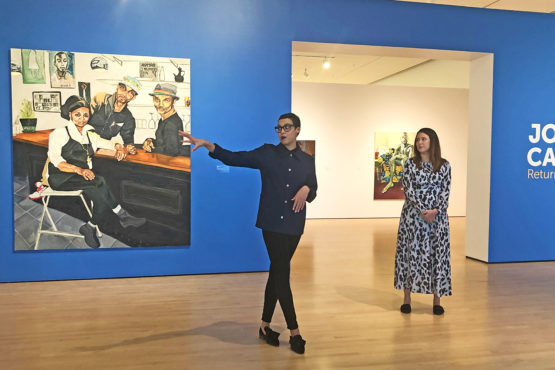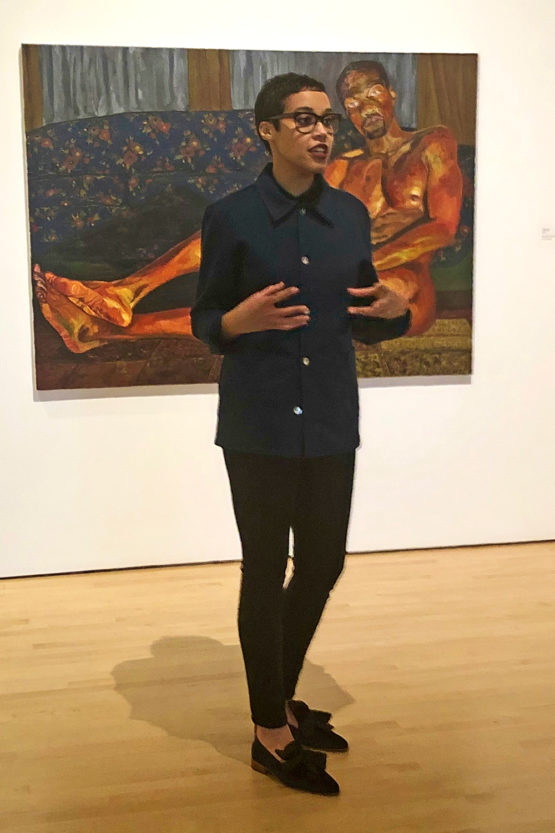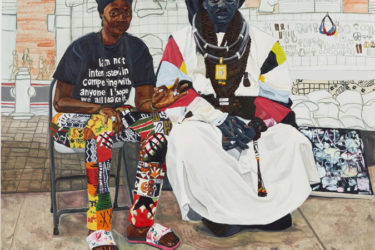Artist Jordan Casteel’s first solo museum exhibition makes its West Coast debut at Stanford’s Cantor Arts Center
Casteel creates portraits that connect viewers to her neighbors who became her friends, and her friends who became like family.
Jordan Casteel, widely recognized as one of the most innovative emerging artists working today, brought her first solo museum exhibition, Jordan Casteel: Returning the Gaze, from her hometown museum in Denver to the Cantor Arts Center. This is the second and final venue for the exhibition, which is on view through Feb. 2, 2020.

Artist Jordan Casteel gestures to her painting Benyam (2018) on view at the Cantor Arts Center’s presentation of “Jordan Casteel: Returning the Gaze.” (Courtesy of the Cantor Arts Center)
The exhibition features 29 paintings made in the last five years, many featuring people Casteel encountered while walking around her Harlem, New York, neighborhood. Upon returning to her studio, photographs she took of her subjects became the source material for electrically colored, large-scale painted portraits that chronicle Casteel’s personal observations of the human experience.
“Her monumental, exquisitely tender paintings remind us that everyday existence can also be extraordinary,” said Aleesa Pitchamarn Alexander, assistant curator of American art at the Cantor.
The title of the exhibition, Returning the Gaze, acknowledges the many levels of engagement within Casteel’s work. There is Casteel’s personal engagement with her subjects as a neighbor and artist, and the subjects in the works are often depicted gazing straight out of the canvas, engaging viewers and holding their attention.

Artist Jordan Casteel in front of her painting Yahya (2014) at the Cantor Arts Center. (Courtesy of the Cantor Arts Center)
The broad exhibition reveals Casteel’s evolving practice. Inspired to address ideas of black masculinity, Casteel began by painting portraits of those closest to her including family members, friends and boyfriends, to transform the negative representations of black men often encountered in society.
The result was her early series, Visible Man (2013–14) and Brothers (2015), which include details such as furnishings and personal belongings that deepen the viewers’ understanding of the subjects. Casteel also decided to paint some of her male subjects in the nude, after discovering that clothing seemed to mask the essential humanity of those she was painting.
“I think a lot of this has to do with historical painting and the notion of who has the right to depict what bodies at what scale,” Casteel wrote in the catalog produced by the Denver Art Museum that accompanies the exhibition. “I was really interested in humanizing a history that is often criminalized and sexualized. I didn’t want the black male body to be taken advantage of any more than historically it has been.”
Included in the exhibition are works from Casteel’s 2017 series Nights in Harlem, an investigation of light and color. Other subjects represented in the exhibition include cityscapes, subway scenes, women and local business owners.
Having Casteel’s work at the Cantor complements ongoing conversations in the museum’s galleries about representation, including discussions about who is represented and the artists doing the representing.
“A portrait historically has been a physical manifestation of one’s wealth, because you had to pay considerable sums of money to have yourself represented that way, so often the images we have in portraits are of wealthy white people,” Alexander said. “Initially you might not think that just painting your community members would be a radical gesture, but when looked at in the larger context of art history, it’s a radical and deeply empathetic gesture.”
Born in 1989 in Denver, Colorado, Casteel earned her bachelor’s degree from Agnes Scott College in Decatur, Georgia, and her Master of Fine Arts degree in painting and printmaking from Yale School of Art in New Haven, Connecticut. She now lives and works in New York and is an assistant professor at Rutgers University-Newark. Her work is included in public collections at The Studio Museum, MOCA Los Angeles, The Ford Foundation and Crystal Bridges Museum of American Art.
Casteel, who was the inaugural artist honoree at the Museums By Moonlight gala, the annual event that supports the Cantor and Anderson Collection at Stanford University, was recently profiled in both the New York Times and Vogue magazine and was named to Forbes 30 Under 30 list of influencers in art and style in 2019.
While on campus, Casteel gave a gallery tour to undergraduate students in a survey course offered by the Department of Art and Art History in the School of the Humanities and Sciences that examines works made by African American artists in the United States and abroad. She also spent time in the classroom discussing how artists have contended with issues of race, gender and sexuality and how collectors and museums make decisions about their collections.
The Cantor plans to offer two in-gallery talks by Alexander, one on Thursday, Oct. 24, from noon to 1 p.m., and the other on Thursday, Jan. 16, from 1 to 2 p.m.

Image credit: Courtesy of the artist and Casey Kaplan

Image credit: Courtesy of the artist and Casey Kaplan

canvas, 72 x 54 in. Adam Green Art Advisory on behalf of a private collection. ©Jordan Casteel.
Image credit: Courtesy of Sargent's Daughters, New York

in. Denver Art Museum: Purchased with funds from Vicki and Kent Logan; Craig Ponzio; Bryon Adinoff and Trish Holland; Devon Dikeou and Fernando Troya; Suzanne Farver and Clint Van Zee; Baryn, Daniel, and Jonathan Futa; Andrea and William Hankinson; Amy Harmon; Lu and Chris Law; Sharon and J. Landis Martin; Amanda J. Precourt; Judy and Ken Robins; Annalee and Wagner Schorr; Judith
Zee Steinberg and Paul Hoenmans; Ellen and Morris Susman; and Margaret and Glen Wood. ©Jordan Casteel
Image credit: Jordan Casteel
